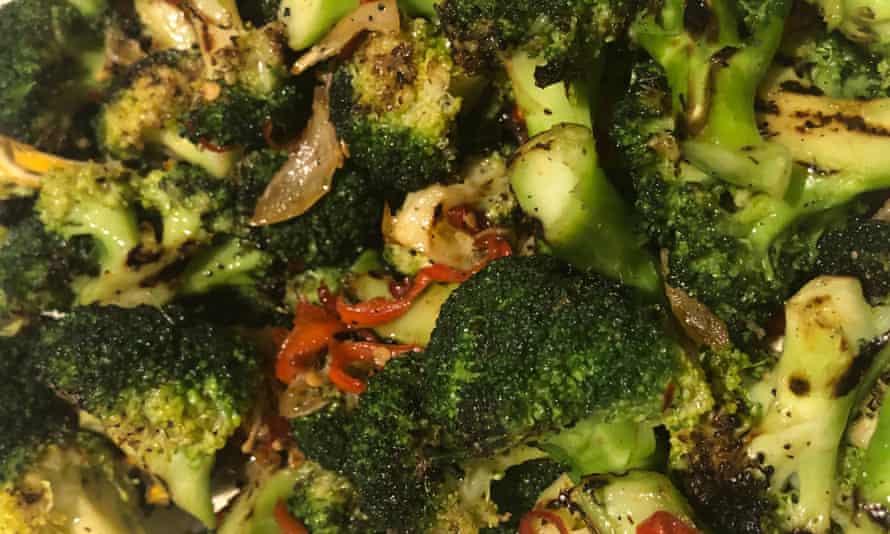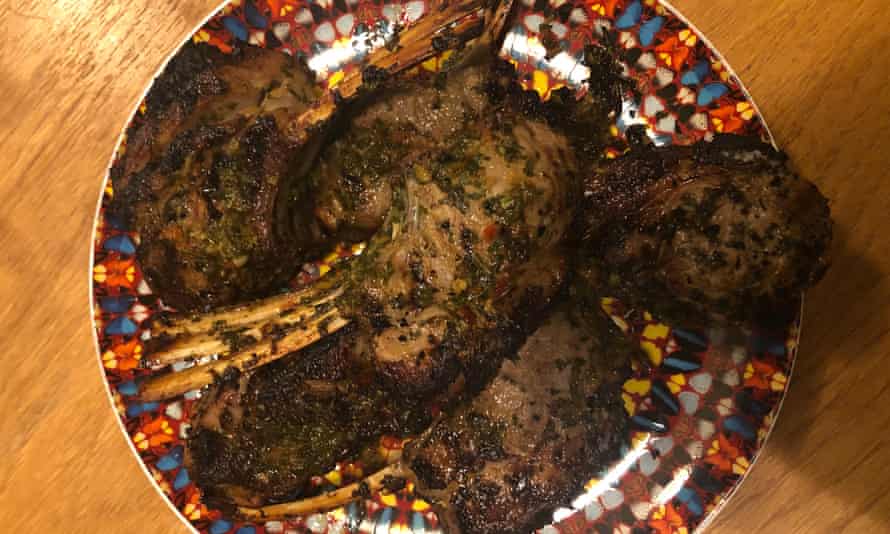In 2002 the literary agent Felicity Rubinstein found herself drawn to a white-walled deli that had just opened around the corner from her home in London’s Notting Hill. It was called Ottolenghi and its food display was a riot of colour and promise. Eating it looked like it might be a quick route to feeling good about yourself. “I became rather obsessed with it,” she says now. “I reckoned it wasn’t difficult to make this food. I just had to know what was in it.” Soon Ottolenghi opened an outpost in Islington. Sarah Lavelle, then an editor at Ebury Books, lived close by. “I went down one weekend and people were queueing out the door. I thought, ‘Something’s going on here.’” Merope Mills, then editor of the Guardian’s Weekend magazine, also visited. “I was looking for a new vegetarian cooking columnist,” she says. “And I was struck by all these brilliant-looking salads.”
These three people, all in powerful media positions, were drawn to an extraordinary retail display: of rugged vegetable dishes spiked with chilli and lemon, with the green of fresh herbs against the vivid orange of roast squash; to heaps of buxom cakes, honey-slicked pastries and pert, snowy meringues. Each would play a part in launching a publishing phenomenon; one which has so far shifted around 7m copies worldwide. Its cornerstone is the original Ottolenghi, published in 2008; a book which introduced the UK to the then exotic joys of tahini, sumac and za’atar. It’s not yet 15 years old, but to flick through its pages is to glimpse the self when young, before charring broccoli was a thing. To think, there was a time when all we did was boil it.

“Yotam has literally changed what supermarkets stock,” Mills says now of the Israeli chef and writer, who in the 90s gave up studying for a PhD for a life of cooking in London. When she first approached him about the vegetarian cooking column he pushed back, pointing out he wasn’t vegetarian. “Eventually he compromised, though he suggested his first vegetarian recipe be served with lamb. That caused a huge fuss.” There were other rows, too, mostly over lists of ingredients that readers hadn’t heard of. “But very soon it became clear he was developing a cult following,” Mills says.
Rubinstein was now agent for what had never just been one man but a team, led by Ottolenghi and Sami Tamimi, who had joined from Baker & Spice. The success of the column provided a platform from which to sell the Ottolenghi book she had long believed in. At which point I should confess: my then fiction publisher, Atlantic, asked me to look at the proposal. I told them not to bid, because cookery books are expensive to publish and this one wouldn’t sell. Which is why I’m not a publisher. Rightly, Atlantic ignored me and bid, though it went to Ebury and Lavelle. “I honestly didn’t know how huge it was going to be,” Lavelle says. “But I knew it was exciting.” The book would go on to sell hundreds of thousands of copies in the UK alone – so many indeed, that at first Ebury couldn’t keep up with demand.

In the front section, entitled “Our food philosophy”, it acknowledges that British food had improved immeasurably, something in which people had started taking pride. “Then suddenly they were made to feel guilty for having fun,” the introduction says. “It is all about diets, health, provenance, morals and food miles. How boring and what a mistake.” Ottolenghi agrees it was a call to arms, a rebel yell in support of sensuality, vivacity and appetite. “I still think like that sometimes,” he says.
Elsewhere, the book lays out its stall through the medium of lemon and garlic. “What makes lemon and garlic such a great metaphor for our cooking is the boldness, the zest, the strong, sometimes controversial flavours of our childhood.” Again, it’s sweet to see what is now a benign double act, rubbing up against the word “controversial”. We have moved on, with this book as our guide. We are fluent in harissa, pomegranate molasses and labneh. “The fuss over the ingredients never really bothered me,” Ottolenghi says. “There are complicated recipes and there are simple ones.” As he points out, one of the most popular is for mangetout with hazelnuts and orange, which has only six ingredients. “We did invent a visual language for our food, but, flavour-wise, these are all familiar things.”

Chef Josh Katz, now of Berber & Q, joined Ottolenghi from the impeccably French Galvin de Luxe Bistro on Baker Street, just as the book was being published. “I think of them as magicians,” he says of Ottolenghi and Tamimi. “They took simple ingredients and made them sing. I was struck by how free this food was after the rigour of French cooking.” Up to a point. I make the charred broccoli with chilli and garlic, one of those dishes most associated with the Ottolenghi name, and their determination to give vegetables star billing with meat. It requires the blanching of the florets for two minutes. “Don’t be tempted to cook it any longer,” the recipe insists. Yes, sir.
I leave them to dry, add a little olive oil, salt and pepper and put them on a hot griddle, until they char. It feels almost subversive, this controlled burning of the fresh and the green. But the broccoli becomes a textural joy and offers up layers of unexpected flavour, as do handfuls of chillies and garlic, simmered in olive oil. I am invited to add anchovy fillets. Such invitations should never be refused. I also make the lamb cutlets, which are first introduced to a multilayered marinade of blitzed mint, coriander and parsley. Acidity comes from both vinegar and lemon juice. There is chilli and honey, ginger and salt and, of course, garlic. There usually is. They are griddled then roasted and are a supreme exercise in blackened bone-nibbleage.
I ask Ottolenghi which sweet thing I should attempt. He nominates the apple and olive oil cake with maple icing. It’s a clever piece of work, full of the texture of apple and sultanas, and with an outrageous frosting, underpinned by cream cheese. “That’s still on our counter and it sells very well,” Ottolenghi says. It disappears quickly off my counter, too, though I fear the icing on mine is a little under-whipped. Oh well, I will just have to mark the page and try again. Like so many people, I am happy still to be living out the Ottolenghi years.
Ottolenghi: The Cookbook, by Yotam Ottolenghi and Sami Tamimi, is published by Ebury. Buy a copy for £27 from guardianbookshop.com
News bites
Koya, renowned for the thick, slippery udon noodles served at their two London outlets, has launched an ‘omiyage’ box, delivered nationwide by standard post. Each box costs £14 including that postage, and contains two substantial servings of both their noodles and dashi broth. The delivery comes with a recipe card, supplemented by ‘how to’ videos on Instagram demonstrating how to make Koya’s most popular dishes, including lamb cumin miso and pork miso. Visit koyamail.co.uk.
18 March sees the publication of Chefs at Home, a collection of lockdown recipes from over 50 of the UK’s best-known chefs, with all royalties going to the charity Hospitality Action, which supports people in the industry needing help. Contributions include recipes for Lyonnaise onion soup by Michel Roux Jnr, Singapore noodles by Andrew Wong and ‘ultimate’ fish and chips by Nathan Outlaw. The book is available for pre-order from all good booksellers, price £26.
Generally, I use these news bites for offerings delivered widely. Excuse one that’s exceptionally local, just to Sydenham in south London. During lockdown a chef from Tomos Parry’s live fire restaurant Brat has opened a small outfit called Smor Bakery, delivering a changing range of what sound like outrageously good sweet and savoury pastries. They include ’nduja, fennel and taleggio rolls, lamb and mint sausage rolls, maple syrup and pecan cookies and rum and raisin bread puddings. Message them through bakery.smor on Instagram.
Email Jay at jay.rayner@observer.co.uk or follow him on Twitter @jayrayner1
from Lifestyle | The Guardian https://ift.tt/3ulY7Bk
via IFTTT

comment 0 Comment
more_vert